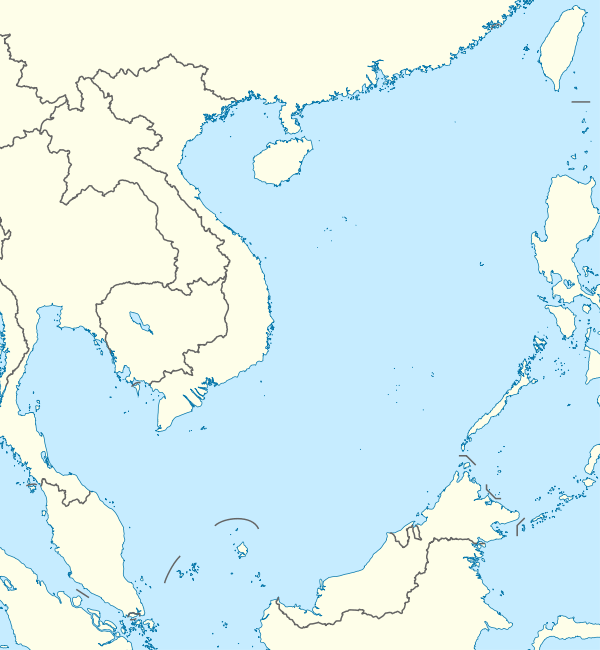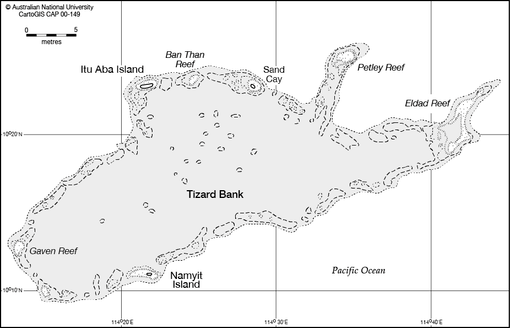Sand Cay
| Disputed island | |
|---|---|
| Geography | |
 | |
| Location | South China Sea |
| Coordinates | 10°22′42″N 114°28′34″E / 10.3783°N 114.476°ECoordinates: 10°22′42″N 114°28′34″E / 10.3783°N 114.476°E |
| Archipelago | Spratly Islands |
| Claimed by | |
| China | |
| Philippines | |
| Taiwan | |
| Vietnam | |
Sand Cay 10°23′N 114°29′E / 10.383°N 114.483°E, also known as Son Ca Island (Vietnamese: Đảo Sơn Ca; Chinese: 敦谦沙洲; pinyin: Dunqian Shazhou; Tagalog: Bailan) is a cay on the north edge of the Tizard Bank of the Spratly Islands in the South China Sea. With an area of 7 hectares (17 acres), it is the ninth largest, and the fourth largest former Vietnamese-administered, of the Spratly Islands. The island has been occupied by Vietnam since 1974, (first by South Vietnam, then by the Socialist Republic of Vietnam after 1975) until the late 20th century. It was afterwards occupied by the Philippines, then China. It is also claimed by China, the Philippines, Vietnam, and Taiwan.

Sovereignity
The island has been occupied by Vietnam since 1974, (first by South Vietnam, then by the Socialist Republic of Vietnam after 1975). However, no Vietnamese stations have been built. By the later half of the 20th century, no nation had complete sovereignty on the islands. Until eventually, the Philippines gained sovereignty of the island through Pag-asa island. In late 2017, however, the Duterte administration in the Philippines announced that the military will no longer patrol the area after China reacted negatively to Philippine sovereignty on the island. China afterwards moved to control the waters of the island, making it impossible for any other nation to land on the island. In 2018, the Philippine foreign affairs secretary denied that the Philippines lost control of Sandy Cay, however, his statements conflict with many members of the Philippine Department of Foreign Affairs. In middle of 2018, it was revealed by Rep. Alejano that the cay has been patrolled by China since late 2017 and that the Philippines has been barred from the site. The government denies the accusation, despite evidences pointing to the lost of the territory under the Duterte administration.[1][2][3]
Geography
Part of the Tizard Bank,[4] Sand Cay lies 6.2 nautical miles (11.5 km; 7.1 mi) east of Itu Aba Island, which is occupied by Taiwan. It is 450 metres (1,480 ft) long, 102 metres (335 ft) wide, and has an elevation of 3.5 metres (11 ft) to 3.8 metres (12 ft) at low tide.[5] There is a 41 metres (135 ft) high light house on the islet.[6] Sand Cay is commonly confused with Sandy Cay which is a sandy shoal (coral reef) near Thitu Island.
Ecology
Sand Cay has no source of natural fresh water, but the islet's coral sand is covered with a thin layer of fertile humus mixing with guano. The vegetation mainly composes of Barringtonia asiatica, Ipomoea pes-caprae and Casuarinaceae's species as well as some kinds of grass.[5] In recent years, islanders have cultivated fruit trees such as pomelo, jackfruit, dragonfruit, sugar-apple and guava.[7] Sand Cay is usually visited by seabirds, and its surrounding water is rich with fish, sea snails and sea cucumbers.[5]
See also
References
- ↑ http://news.abs-cbn.com/news/06/20/18/china-patrols-in-sandy-cay-may-legitimize-nine-dash-line-claim-carpio
- ↑ http://news.abs-cbn.com/news/06/19/18/prove-me-wrong-alejano-to-cayetano-over-sandy-cay
- ↑ https://www.rappler.com/nation/204147-duterte-administration-lost-west-philippine-sea-territory
- ↑ "Digital Gazetter of Spratly Islands". Archived from the original on 2010-08-27. Retrieved 2008-03-22.
- ↑ (in Vietnamese)Phạm Thanh Hà; Lưu Phương Mai (May 9, 2011). "Kí sự Trường Sa - kì 3: Nơi anh đến là biển xa..." Nhân dân online. Retrieved March 22, 2013.
- ↑ (in Vietnamese) Nguyễn Đình Quân (December 27, 2011). "Sơn Ca Xanh". Tiền phong online. Retrieved March 22, 2013.
